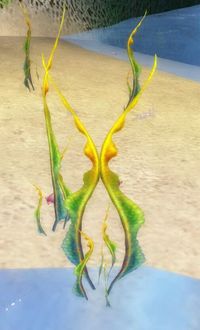Дуле — различия между версиями
Материал из ЭнциклопАтис
Lanstiril (обсуждение | вклад) м |
Lanstiril (обсуждение | вклад) м |
||
| Строка 22: | Строка 22: | ||
The '''сацча''' is consumed as food too, but it also produces a green dye used by artisans. | The '''сацча''' is consumed as food too, but it also produces a green dye used by artisans. | ||
| − | <noinclude>[[File:Saltorns-Summer.jpg|300px|thumb| | + | <noinclude>[[File:Saltorns-Summer.jpg|300px|thumb|right|Салторнс in summertime]]</noinclude> |
{{Clear}}{{Last version link|Дуле}}<noinclude>{{Портал|Флора}} | {{Clear}}{{Last version link|Дуле}}<noinclude>{{Портал|Флора}} | ||
{{TIP|DE=4|EN=4|ES=4|FR=0|RU=}} | {{TIP|DE=4|EN=4|ES=4|FR=0|RU=}} | ||
Текущая версия на 16:07, 22 ноября 2019
This short seaweed of webfoot shape is bright green in summer and displays various other colours in other seasons.
The дуле often grows in the company of a smaller cross-stemmed species in the shape of tiny ladder, the салторн.
Both of them have a peppery flavour and are eaten in salads in summer.
The high green algae in the luciogram opposite are сацчас.
The сацча is consumed as food too, but it also produces a green dye used by artisans.
Последняя версия 2019-11-22•ᐒ
| |
| |






